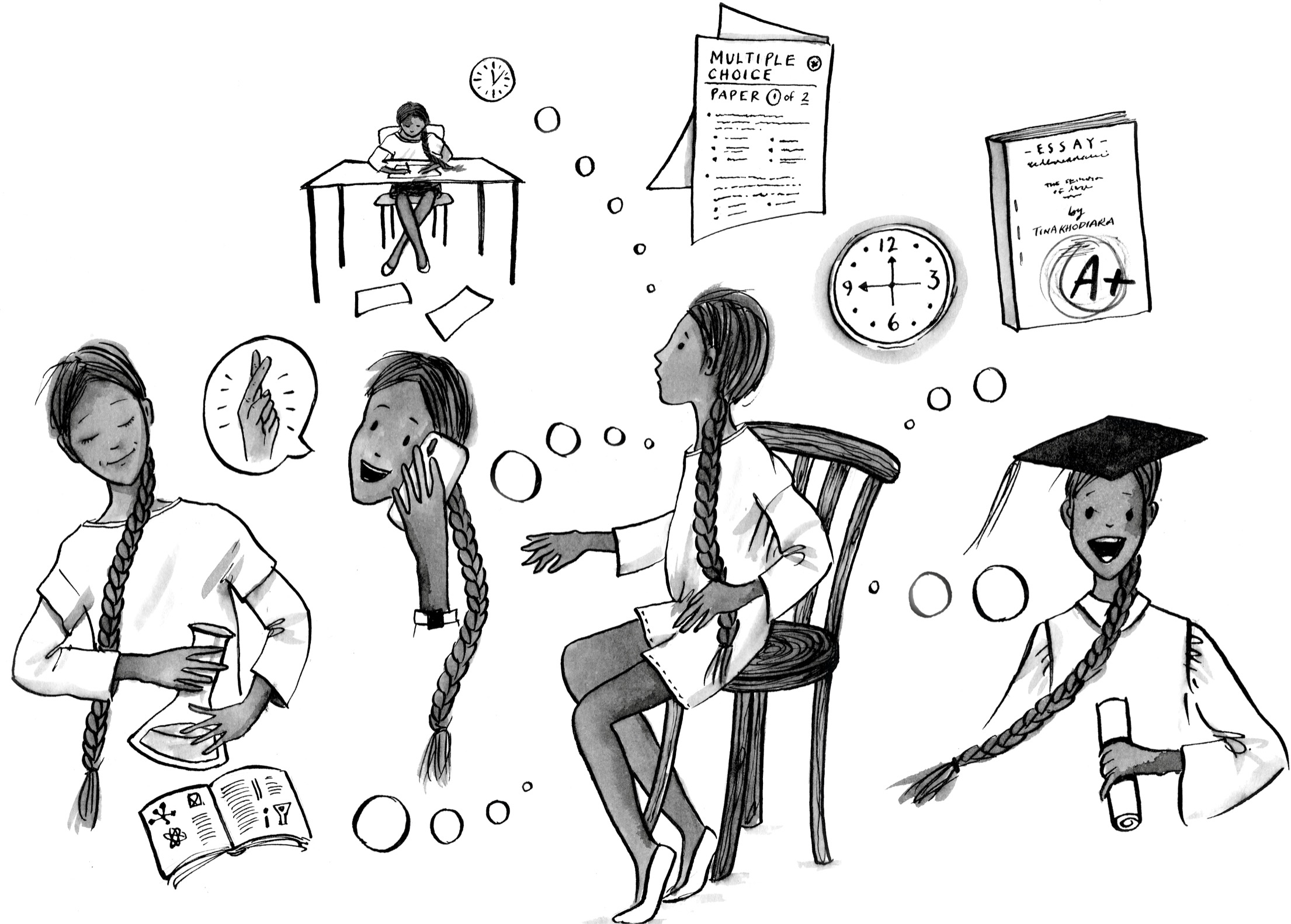 CHAPTER 5
CHAPTER 5 
Facing Your Fears
To be brave you must first be afraid. Being brave isn’t about not feeling scared. Real courage is all about overcoming your fears.
—Bear Grylls, professional adventurer

When I tell people that I want to become an astronaut, there’s a standard set of comments and questions that generally follows. Responses might include anything from surprise and shock at me having such a big dream, to questions about how exactly one becomes an astronaut, to a couple of overused jokes about space cadets. But the one response that pretty much never fails to crop up? That would be people’s questions about fear. Time and time again I’ve been asked questions like: Are you afraid of space? Of sitting on top of a rocket made out of essentially the same materials as a bomb? Of dying in space and never seeing your family or Earth again? Are you afraid of telling people about this dream and then failing to accomplish it?
People tend to ask these questions for a very good reason. Space—and by extension, human space travel—is scary. It’s at the top of the list of the most inhospitable places imaginable for humans. Outer space oscillates between being a frozen tundra and a boiling expanse, often over periods of just a couple hours. There’s no oxygen, no water, and no food to be found. Spring a leak in your spaceship or space suit and you risk suffocating in the vacuum of space. You’re constantly surrounded by radiation, some of which is completely unpredictable in direction and frequency. And all of that’s just after you’ve actually reached space—getting to and from space has its own complex layers of danger (in fact, over the last five decades of human space travel, almost all astronaut deaths have occurred during takeoff and reentry).
Physical safety and well-being aside, becoming an astronaut is an extremely competitive aspiration—the chances of actually accomplishing it are very, very small, and therefore, the chances of failing to reach outer space are quite large. Suffice it to say, fear at the prospect of becoming an astronaut is a normal part of having this dream.
But here’s a secret—having a dream is an inherently scary thing, regardless of what that dream is. Becoming an astronaut is a rather extreme example of the fear involved in dreaming, but whether or not a dream involves actual physical danger, every dream invokes fear of failure, fear of the future, and fear of the unknown.
This might all sound really gloomy, but here are three pieces of good news: First off, you’re not alone! So many dreamers and doers before you have faced these same fears and come out all right on the other side (and likewise, every dreamer after you will face the same types of fears as you do). Secondly, having fears and doubts doesn’t have to stop you from chasing after (and achieving) your dreams—as long as you know how to manage those fears. And lastly, your fears can actually work to help you achieve your dreams, once you learn how to master them!
It’s completely normal for chasing after your dreams to be a scary thing. Fear is one of the most basic and innate parts of human nature. It takes courage to have a dream, to talk about that dream, and ultimately, to act toward that dream! Remember, courage isn’t the absence of fear, but rather the ability to act in spite of it. It’s the thing that allows you to chase after your dream regardless of any doubts you might have. And it’s something you can build by facing your fears and anxieties head-on, sizing them up, and learning how to manage them.
As you set out on the path toward achieving your dreams, there are all sorts of fears you might face. You might be afraid of not accomplishing your dream, of finding yourself in new situations and trying new things, of sharing your dreams and goals with the world, or of the general unknown-ness of the future. This chapter will help you learn to recognize your fears and doubts, develop skills to control and manage them, and ultimately, help you use your fears to guide your path instead of letting them block it.

UNDERSTANDING FEAR
There’s a well-known quote from Sun Tzu’s The Art of War that says, “Know thy enemy.” What this piece of advice means at its core is that the very first step to mastering anything standing in your way—whether it’s an actual opponent or the roadblock presented by your fears—is to understand it. As you face your fears, it helps to understand them both in the more general sense (What is fear? Why do humans experience it? What purpose does it serve?) and in the personal sense (What are the specific fears that surround your dream? Why do you fear these things?). Before we get to the specific fears, though, let’s start with trying to wrap our minds around fear as a general human experience.

Fear is one of our most basic emotions. If having dreams is part of what makes us human, having fears is the flip side. At its core, fear is important to humanity because it has allowed us to survive—and as such, shaped the path of our evolution. Throughout all of human history, it was the people who feared the right things (and, as a result of that fear, avoided them) who survived long enough to have and raise children—children who would then carry on those same fear instincts. This is why you likely have fears that you struggle to articulate, but that somewhere deep down you feel are important. For example, a fear of snakes would have been important to your distant ancestors, who spent a lot more time sharing the same environment as them. They were much more likely to encounter, and perish from, a venomous snake than you are today. And yet, even though you no longer face that same danger from snakes, you still have the instinct to be afraid of them. Fear exists for a reason, and as such, should be listened to and respected. But as the previous example shows, not every fear is equally valuable to us (or to you and your individual circumstances)—so blindly accepting your fears and allowing them to dictate your life probably won’t work out so well, and definitely won’t help you accomplish your dreams.
There are two main points that I think are important to note when considering fear as a central human experience. First, that fear is a byproduct of thinking about and striving toward the future—it’s something that helps humans survive and create a future for themselves. And second, that everyone experiences fear at some point, which (like having dreams!) makes it something that ties us all together. All of which is to say that, as much as we may dislike or even dread fear, there’s something comforting about knowing that none of us are alone in experiencing it. And since fear is connected to anticipating the future, it’s very normal and expected to experience fears and doubts when you start thinking about your future more.
Everyone reacts differently to the emotions and feelings they have surrounding the future. While everyone experiences fear, not everyone is equipped to deal with it—and that makes a big difference. If you don’t think about fear and how to handle it before it actually occurs, you likely won’t be entirely prepared when you actually encounter it, and it could become an insurmountable roadblock on the path toward your dream. But defining your fears now, and learning how to handle them, will undoubtedly help you as you continue on your way. How do you actually go about recognizing and managing your fears, though? Let’s dive in!

MANAGING FEAR
I’ll say it again because it’s so important: fear is normal, happens to everyone, and is an inescapable part of having and chasing a dream. We can’t avoid experiencing fear, but what we can do is make sure that our fears don’t hold us back from our dreams. To do that successfully, it helps to have a two-pronged approach, incorporating both inward-focused self-reflection and outward-focused action.
Self-reflection is great for helping us discover and understand our fears. It makes sense, doesn’t it, that to combat our fears we have to first recognize what exactly it is we’re afraid of, determine why we’re afraid of those particular things, and ultimately choose to value the benefits of facing our fears.
Managing fear by taking action is equally helpful, though! Just knowing what it is you’re afraid of (and why!) oftentimes won’t be enough for you to fully mitigate the negative effects of that fear—instead, you need to take actions to prepare for and overcome your fears.
Read on for more on how to combine self-reflection and action to not only face and overcome your fears, but also turn your fears into a positive force that will help drive you to accomplish your dream. I know that might seem counterintuitive, but believe me, it works!

DISCOVER YOUR FEARS BEFORE THEY DISCOVER YOU
Just like the first step to chasing your dreams is to figure out what your dream is, the first step to managing your fears is to figure out what it is that you’re afraid of—and why! Why? Well, thinking about what your fears are before you actually encounter them will allow you to be much more prepared when you do.
This might be easier for some people than others—and it might be easier to pinpoint certain fears over others as well! In fact, you might have a fear that you’re already aware of, and you might even already recognize how it affects your dream. I had that happen to me when I was a kid, because I knew full well about one fear that I had: I was deathly afraid of needles. This is a big problem for someone aspiring to become an astronaut since astronauts are essentially the guinea pigs of space travel: to learn more about the effects of space travel on humans, astronauts have to submit to all kinds of health examinations and experiments before, during, and after their time in space. It’s very likely that those examinations and experiments will include things like taking blood samples or administering medicines intravenously, all of which boils down to needles being a not infrequent occurrence for space travelers. I knew about this fear of mine early on, because needles are something I’d already encountered by way of flu shots and other necessary immunizations, and was able to connect it to my dream after reading accounts of what it was like to travel to space from past astronauts.
Knowing some of your fears ahead of time is great, and can definitely help you on your way to overcoming them. But of course, not all fears are quite so easy to get a handle on—either because you haven’t encountered them yet and therefore can’t possibly know to be afraid of them, or because some fears are simply more elusive and difficult to pinpoint than others. This second possibility might be the case if your fear is of something that’s not physical: recognizing that you’re afraid of something tangible (like heights or swimming) is much easier than realizing that you’re afraid of something abstract (such as failure, rejection, or change).

CHOOSE TO FACE YOUR FEARS
It may take you some time to discover your fears, and new ones might even crop up as you continue down the path toward your dream—and that’s okay! There are some fears you really won’t know about until you start down the path toward your dream. For example, if you want to become a soccer goalie, it might take trying to play a game or two to realize that you’re afraid of objects flying at you! Whenever you do encounter fears, though, it’s up to you to make the deliberate choice to face them. Facing and overcoming your fears can be difficult, and to do it successfully, you’ll need plenty of self-motivation and dedication. So the more actively you choose to work past them, the more likely you are to conjure up the necessary drive and courage to face your fears head-on. Choosing to face your fears instead of waiting for them to block your path allows you to set yourself up for success—you get to handle them at your own pace, in a more controlled way, and with as much preparation as possible. Making the choice to face your fears on your terms means that you get to step outside your comfort zone not because you’re forced to, but because you’ve chosen to. And by doing so, you’ll be better able to grow past your fears.

Bear Grylls is one of the most qualified people to talk about choosing to face your fears head-on—both in your broader life and while chasing after your dream! Bear was a serviceperson in the British Army’s special forces unit, and has since become a survival instructor, a television personality in numerous wilderness survival shows, a public speaker, an author, and an explorer of such remote and extreme environments as Antarctica, Mount Everest, and others! Truly, anything that strikes fear into people’s hearts, Bear Grylls has probably already done. He had his fair share of wild adventures and experiences, but there’s one in particular that almost cost Bear his life—and that has since inspired him to tackle his fears head-on at every opportunity. When he was twenty-one years old, Bear broke his back in three places during a skydiving accident, when his parachute failed to deploy properly. He ended up spending a year in rehab, and he wasn’t sure he would ever even walk again. Just eighteen months after the accident, though, Bear not only walked but achieved what had been a lifelong dream of his: to become the youngest British person in history to summit the tallest mountain on Earth—Mount Everest. Since then, Bear has chosen not to let fear stand in his way, no matter what! Just like Bear, you too can overcome your fears, and achieve your dream, by choosing to face your fears head-on.

TAKE ACTION TO FACE YOUR FEARS
Sometimes figuring out what it is that you’re afraid of—and why—is enough to help you get over those fears and keep them from affecting your ability to chase after your dream. The human brain is amazing—just recognizing what your emotions are and why you’re feeling them can help you control them. But most of us will face some type of fear that we can’t quite shake (I know I have!) no matter how self-aware we are. In these instances it’s good to have other tools that you can count on to help you overcome your fears. And the good news is that there is a wide variety of skills you can develop and utilize to take action in facing your fears. Remember that everyone is different and unique, and the ways that we can successfully manage our fears are just as different and unique. Feel free to choose to use one, a couple, or any other combination of the skills below—whatever works for you!
Consider the “Worst-Case Scenario”
The truth of the matter is that regardless of what we do, at some point in our lives it’s likely that we’re going to fail at things, and that includes failing at overcoming our fears. You could do everything “right” whenever possible as you chase your dreams, and you might still end up failing at something along the way. Life is unpredictable, and many things in it are out of our control. Failure is sometimes inevitable—and in many cases, it can even turn out to be a good thing! We’ll talk about anticipating and using failure to your advantage a lot more in the next chapter, but for now the important thing to keep in mind is that sometimes you might end up in a situation where your fears come true.
A great way to try to overcome your fears is to honestly consider the worst thing that could happen if your fear were to come true—in other words, your worst-case scenario. While it might seem counterproductive to think about the most negative possibility, doing so can actually provide a pathway to feeling less anxiety and stress about your fears. Oftentimes when you think logically about your fears, you’ll find that the worst thing that could happen is not really as bad as you’d been imagining it before. Our brains like to trick us into making mountains out of molehills—when we don’t keep our imaginations in check, our minds can conjure up a worst-case scenario that’s way worse than anything that could ever really happen. Use the following guided journaling to ensure that you’re keeping your fears properly sized and not letting them get bigger than they need to be!

Turn Your Fear into Excitement!
Rather than searching for calmness in the face of fear, consider embracing the heightened emotions that come along with it. Turning your fear into excitement is one of the fastest and most effective ways to fuel your dreams. Let’s think about why this works.
One of the most important ideas to remember is that, when you feel fear, you don’t just experience it by way of intangible thoughts and emotions. You do have those, but in addition, your body reacts with physiological changes, including things like an elevated heart rate, fast and shallow breathing, or even an adrenaline rush. These responses are related to a concept you may have heard of called the fight-or-flight response. Essentially, your fear triggers your body to either run away from or stand up to the thing causing you fear, and it provides you with the physical tools to help you do one or the other. But when you think about it, these responses that your body offers up are pretty similar to the physical responses you experience when you’re excited about something! Because of this, it’s much easier to transfer your fear into excitement than it is to do a full about-face and completely switch to a calm state of mind.

The very first step in shifting fear to excitement is recognizing when you’re feeling afraid. When you start to feel anxious, nervous, or afraid of something, take a couple deep breaths and a moment to analyze your thoughts. Shifting fear to excitement is all about catching your fears early on and changing the way you’re thinking about the thing causing you fear. For example, if you’re afraid or anxious about your first day of basketball practice, dance class, or anything else that you’re trying for the first time, you might be having thoughts along the lines of: What if I’m not good at this thing?, What if I embarrass myself in front of my peers?, or What if I mess up? It’s very normal to feel negative thoughts when you’re experiencing fear. But if you realize that you’re thinking these things because of the fear itself, and not necessarily because they’re true or logical, you can try to change them! In this instance you might try to offer yourself responses to your internal questions such as: The fact that I’m new means I have a lot of potential to improve!, Everyone is going to be new—nobody will be judging me!, and I’m doing this thing because I’m interested in it—I’m going to have fun! The key to this shift is to make sure that the new thoughts that you’re introducing feel true to you. Next time you find yourself in a fearful moment, try shifting your fear into excitement!
Cultivate a Growth Mindset!
Much like shifting your fear into excitement, this next skill for managing your fears requires a conscious and intentional shift of thought. Cultivating a growth mindset is a great tool to use, and it can help you feel more comfortable and less wary of chasing your dreams and overcoming your fears. But wait, I can almost hear you asking, what even is a “growth mindset”? Great question.
The basic theory here is that people can have a “fixed mindset,” where they believe that their abilities, talents, and potential are all set in stone and unchangeable, or a “growth mindset,” where they believe that they can change these things—and improve them—over time. The byproduct of each mindset is then fairly obvious, right? A fixed mindset removes your personal agency, taking away your ability to work hard and work smart toward improving, while a growth mindset enables you to hold on to those very things. Let’s look at an example of how this might affect a dream!
Say you want to learn another language. When you first start out, you might struggle with certain aspects of it, such as new rules for spelling, sounds that you’re not used to using, different grammar patterns, new vocabulary to memorize, and more! If you have a fixed mindset, you’d believe that you’re not capable of learning new skills or changing how you think—what’s hard at the beginning will stay hard as you continue to learn more of the language. However, if you have a growth mindset, you’d recognize that these things are all skills that you can improve on, even if you’re not very good at them to start off with!
Most of us have some combination of fixed and growth mindsets already. The exciting thing is that you can increase the amount of time you spend building a growth mindset! Doing this involves two main things: self-reflection and practice. Many of the self-reflection activities throughout this book can help you develop the skills to look inward and analyze your thoughts, ideas, and abilities. As you do them, keep in mind that you always have room for improvement—and then act accordingly! Cultivating a growth mindset is all about increasing the quantity and quality of time you spend practicing your chosen skill—essentially, to improve at something you have to not only spend more time on it but also make sure that time is focused. Put in the time and effort to improve, and know that the results can surprise you!
Practice Visualizing Your Fears!
In addition to cultivating a growth mindset and practicing consistently, another way to work on overcoming your fears is through visualization. Visualization is when you think of or imagine something before it’s actually happened, and it can be a powerful tool. Successful people in all fields use visualization to improve their skills and prepare themselves for success. It’s very common among professionals ranging from athletes to musicians and even pilots! In fact, it’s so common for pilots to learn through visualization that there’s something called “chair flying,” when a pilot sits down anywhere that isn’t actually in an airplane, closes their eyes, and then imagines the cockpit. The pilot then goes through the various steps of takeoff, landing, emergency procedures, and more—all in their imaginary airplane.

I myself am a pilot, and this “chair flying” method actually saved my life once. That might sound like an exaggeration, but it’s true! When I was training to be a pilot I spent a lot of time thinking about all the things that could go wrong in the air—engine fires, radio failures, stalls, and more. Having the responsibility for not just my own life but also the lives of my passengers made me afraid in a way I’d never been afraid before. But I couldn’t fly if I allowed that fear to control me. Practice, through visualization or “chair flying,” was the solution that let me instead be in control of—and actually benefit from—my fear. I found that thinking about all of these worst-case scenarios, and then practicing the solutions to them through visualization, made me a more confident and courageous pilot. In-flight emergencies (like most worst-case scenarios) are rare—but they do happen. By “chair flying,” I knew that when (not if) an emergency happened while I was in the pilot seat, I’d be able to handle it because I’d already thought through my options, chosen a course of action, and developed muscle memory so that I could react immediately. Essentially, I’d already handled each emergency dozens of times before and been successful at doing so.
This philosophy of preparing for both success and failure served me well when, during a practice flight before my final examinations, I was demonstrating how to recover from a stall and ended up in a spin. A stall is a situation in which too little air flows over the wings of the plane to continue creating the lift needed to hold the plane in the air. As you can imagine, not enough lift leads to an airplane losing altitude instead of gaining it! That was bad enough on its own, but the spin, which is when a plane spins uncontrollably around one wing and loses altitude, made it even worse. Not only did the plane drop like a rock, but a spin is very disorienting to the pilot—imagine being on a carnival ride where up and down get flipped every second! When my plane spun while I was piloting it, though, I was able to react correctly immediately, because I knew instinctively (after having practiced so much) that recovering from a spin required a specific set of adjustments. I was able to change the power settings, ailerons, rudders, and elevators within seconds, and by doing so, stop the plane from spinning and return to smooth flight.

Now, most situations that you’re afraid of won’t truly be life or death like my airplane spin experience was, but I guarantee that practicing your reactions to fear through visualization will help you to feel confident in your ability to face—and overcome—that fearful moment. While it’s common for people to want to visualize the final result of all their work (winning a gold medal or earning a standing ovation sounds pretty nice to imagine, doesn’t it?), it’s actually more important—and more helpful!—to spend time visualizing the steps you’ll need to take to achieve that final result. This is especially true if you’re using visualization as a tool to manage and overcome fear. Exposing yourself to your fears in your mind through visualization can help desensitize you to those fears, ensuring that you don’t panic when you encounter them, and are instead able to implement the correct actions to ensure a successful outcome.
To create your own visualization of overcoming your fears, start by finding a quiet place where you can focus and relax. Close your eyes and imagine yourself in your fear-based situation. Try to incorporate as many sensory experiences as you can to convince your brain that the visualization is real. For example, if I were to visualize my fear of heights, I might imagine myself walking up to the top of a tall tower and would incorporate the sound of the wind at the top of the tower, the feeling of the gusts rushing over me, and the gnawing sensation that heights give me in the pit of my stomach. You might be totally cool with heights but have a different fear, such as a fear of being in large crowds, or of sudden, loud noises. In those cases you visualizing your fear might include imagining the feeling of lots of people standing close around you, the sound of a whole mass of voices talking at the same time, the sense of tightness that leaves in your stomach; or you might visualize an abrupt crash of thunder and the way it makes your nerves feel jittery.
Visualization is a skill, and as such you shouldn’t expect to be perfect at it right away! It will probably take some practice to visualize the situation as you’d like it to be and to guide yourself through your possible actions. Every time that you work on visualization, try to go through a couple different scenarios of how facing your fears could go, until you find what you think will be your most successful set of actions.

Turn Fear into a Social Experience!

Here’s one of the worst things about fear: it can feel very isolating. I’m sure it won’t shock you to hear that, because chances are most of you have at some point not only felt afraid, but also felt like no one else truly understood your fear. I know I’ve had that happen to me. Happily, though, even if that sense of loneliness is your immediate reaction to certain fears, it doesn’t have to play out that way. All you need to do is take your fears and make them social!
There are two ways that you can turn your fears into a social experience so that you don’t have to feel alone: by finding someone to talk to about them, and by learning about other people who have faced and overcome fear before you. Talking to someone about your fears can be incredibly helpful in managing your level of fear, gaining the confidence to face your fears, and generally seeking out advice on how to overcome them. It might seem scary at first to share your fears with someone else—fear can be a very personal thing. But I guarantee that talking to someone about your fears will be helpful.
If you think that you’d like to talk to someone about your fears, start by thinking about the people in your life who you’d be comfortable talking to about such a personal topic. Just like when you were thinking about who you could share your dreams with, it’s possible that you have multiple people in your life who fit the bill. These people might be family members, teachers, religious advisors, coaches, a therapist, or anyone else you’d like! Because pretty much everyone has faced fear at some point, many people will be happy to help you manage your own fears by listening to you and, if you’d like, offering advice. However, unless you reach out and tell these people that you’re experiencing fear and would like some help, they likely won’t know, and therefore can’t help you! All you have to do is ask.

As you go about chasing after your dreams and facing down your fears, one of the most important things to remember is that, even though it might sometimes feel that way, you are not alone. You are not the first person to feel the things that you’re probably feeling at this point. Worry, anxiety, trepidation—all the emotions that come along with fear are emotions that countless people have experienced before. Not only are you not the first person to feel fear, you’re part of the majority!

Learning about the fears that some of the super-successful dreamers who came before you had, and how they overcame them, can help you to not feel isolated. For example, did you know that the historical leaders Abraham Lincoln and Mahatma Gandhi and famous actors Harrison Ford and Julia Roberts all shared a common fear of public speaking? Wild, right? All four of these people are known around the world for their public speaking and performing, and yet they each started out with serious fear of speaking in front of others. Each of them used specific tools and techniques to ultimately overcome their fear—and the great thing is, we can read up on them and borrow their techniques! So if you have a dream of being in your school play but are worried about getting up in front of a crowd, you can look to people like these as models. And this doesn’t just go for public speaking—I guarantee you that whatever your fear is, someone else has felt it (and overcome it) before you. And in this day and age of the internet, finding out about other people’s successes in overcoming their fears is easier than ever!
I’ll say it one more time: Everyone feels fear at some point in time. It’s natural and normal. But that doesn’t mean that you have to let fear stand in the way of you achieving your dreams. Thinking about your fears in a positive and proactive light gives you the ability to manage them and their effect on you. Most importantly, thinking about your specific fears and how they affect your ability to reach your dream allows you to learn and practice skills to deal with them. The more aware you are of your fears, and your ability to handle those fears, the more likely you are to be successful at achieving your dreams in the long run. Give yourself the opportunity to be your most courageous and confident you by embracing your fears today!
